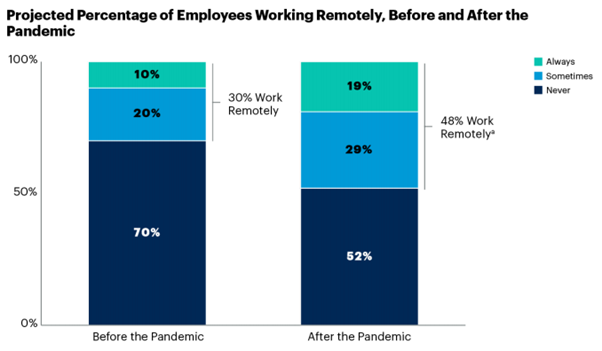|
|
 |
Surprising Statistics on Remote Work in 2022 |

Remote work quickly went from a nice-to-have benefit for some to a standard when it comes to many industries. As a result, companies have literally shifted their entire recruitment ethos to enable a remote working policy. Either that or at a minimum, a hybrid working approach where partial remote working is a possibility.
It has led to companies saving on office costs, while allowing them to conveniently source candidates globally. It's also assisting employees in becoming more productive, removing commute times for many. On average, the commute time saved was around 40 minutes daily.
How the pandemic helped to cause this shift in statistics on remote work in 2022
Maybe you can consider it a silver lining, but the COVID-19 pandemic played an instrumental part in changing how organizations implement work remotely. Whereas it was a small percentage of companies that were fully remote pre-pandemic, it's up to 19% of companies that are fully remote as of 2022. In addition, approximately half of all companies refuse to allow any remote work, a number which is in decline.

Image Source: Gartner
According to Statistics on Remote Work in 2022, business leaders have a conflict
It is not just the operational expense that is feeling healthier these days for companies, it's also employee happiness and engagement. With 83% of employees feeling that they are more productive with hybrid work, including remote work as a standard benefit can go a long way in helping recruit top talent.
In fact, with a survey of 669 CEOs, 78% thought that remote working and collaboration are now part of their normal long-term business strategy.
With that said, an additional challenge that comes from a completely remote workforce, is that of an eroding company culture. For too long, companies have been building their own identities, which have been lost due to the lack of physical interaction among the employees. Employers are watching this and fearing that it could continue to be a trend. They are trying their best to maintain their company culture and team connectedness by creating evolving opportunities for collaboration and team building.
Security is also an issue
Remote work can pose a lot of security concerns for organizations. It's not just about working from home on the Wi-Fi router, which tends to be a more secure access point; it's more about the risk association with open and public WIFIs when traveling out and about. This has caused IT professionals to have this additional concern; who more than half believe is a major security risk. Employees working from remote locations makes it harder for IT to manage individual security parameters than it would be when working completely on-site.
The new normal
Regardless of one’s personal opinion on the matter, remote work is here to stay, and with it comes its own balance of pros and cons. It's all about how we adapt and move forward with this new work model and strive to improve the drawbacks, such as the loneliness or disconnect that employees can feel or the potential security risks involved. Either way, it is already estimated that by the end of 2022, 25% of all jobs (in the U.S.) will be remote.
|
|
|
|
|
|||||
|
© 2026 ShowMyPC. All rights reserved.
|
||||||||


